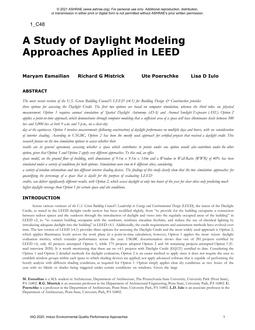Description
The most recent version of the U.S. Green Building Council’s LEED (v4.1) for Building Design & Construction provides three options for assessing the Daylight Credit. The first two options are based on computer simulation, whereas the third relies on physical measurement. Option 1 requires annual simulation of Spatial Daylight Autonomy (sDA) and Annual Sunlight Exposure (ASE). Option 2 applies a point-in-time approach, which demonstrates through computer modeling that a sufficient area of a space will have illuminance levels between 300 lux and 3,000 lux at both 9 a.m. and 3 p.m., on a clear-sky day at the equinoxes. Option 3 involves measurements (following construction) of daylight performance on multiple days and hours, with no consideration of interior shading. According to USGBC, Option 2 has been the mostly used approach for certified projects that received a daylight credit. This research focuses on the two simulation options to assess whether their results are in general agreement, assessing whether a space which contributes to points under one option would also contribute under the other option, given that Option 1 and Option 2 apply very different approaches. To this end, an office space model, on the ground floor of building, with dimensions of 9.1m x 9.1m x 3.0m and a Window to Wall-Ratio (WWR) of 40% has been simulated under a variety of conditions for both options. Simulations were run in 6 different cities, considering a variety of window orientations and two different interior shading devices. The findings of this study clearly show that the two simulation approaches for quantifying the percentage of a space that is daylit for the purpose of evaluating LEED credits, can deliver significantly different results, with Option 2, which assess daylight at only two hours of the year for clear skies only predicting much higher daylight coverage than Option 1 for certain space and site conditions.
Citation: IAQ 2020: Indoor Environmental Quality
Product Details
- Published:
- 2020
- Number of Pages:
- 8
- File Size:
- 1 file , 3.5 MB
- Product Code(s):
- D-IAQ2020-C48
- Note:
- This product is unavailable in Belarus, Russia




